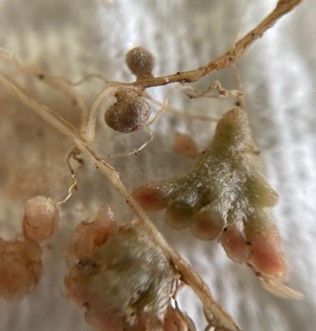Nutrient cycling - Bacteria and Fungi
A three hundred-foot redwood growing from soil that was once molten rock is a mystical process. To understand the magic behind thriving forests and to harness that productivity for agricultural production one must understand the microbes that make up soil.
Every plant, whether a tree or flower, requires a mixture of nutrients to survive. Plants cannot, however, access the nutrients that are locked in organic and mineral forms near their root systems. Even if plant roots had the ability to break down molecules and extract soluble forms of nutrients, the roots are quite large, and although they span a sizable distance, they can only access a small fraction of the surface area of the soil. Plants need help to survive, and they rely on a trusted evolutionary pathway that has formed over millions of years to do so.
The process of unlocking nutrients from otherwise unwieldly materials is called nutrient cycling. The least accessible of these materials is the mineral component of soil, but if the nutrients locked in rocks, sand, and clay can be made plant available they contain a massive supply of invaluable food sources. To gain access to these nutrients, plants rely on bacteria and fungi that utilize a combination of chemical and physical factors to free ions from there crystalline forms. As natural weathering cracks and crumbles stones, they extend their surface area revealing untouched faces ripe for microbial migration. Once the microbes have colonized this new frontier, they begin the process of enzymatically wearing away at the rough carapace of stone. Over hundreds of years these organisms consume nutrients from minerals, slowly increasing a soil’s capacity to harbor life.

There are, however, more efficient ways to make nutrients available to plants from stable organic matter. Species of bacteria and fungi that specialize in breaking down plant and animal organic matter have a much higher proficiency for cycling nutrients. The organic matter that is added to soil through animal and plant wastes can rapidly be integrated into stable organic acids called humus in the O-horizon, or top layer of the soil. Some portion of the biproducts of that degradation will be utilized by the plant immediately but the rest will be stored as humus that can be leveraged later to provide a readily available nutrient pool. In this way humus is like a battery for the soil, storing charge until plants need a boost, and bacteria and fungi are the charger filling that battery.
There are also species of bacteria and fungi that take a more unique approach to increasing available nutrients in the soil. These species rely on symbiotic relationships with the plant’s root system to increase the efficient acquisition of nutrients from their environment. One of the best examples is a species of bacteria called Rhizobia which can store atmospheric nitrogen in an organic from. In doing so, Rhizobia give plants access to a supply of Nitrogen that traditionally would be just outside their reach. In exchange for the assistance, the plant delivers sugars and compounds that the organisms need to thrive. In exploiting these ancient affiliations, plants can rapidly gain access to nutrients in even the most inhospitable of conditions.

The interplay between bacteria, fungi, plants, and the soil comprise the lowest level of interaction in the soil food web. While these interactions are critical to soil health and are the block on which vegetative life must be built, they are only the first step on the journey to a balanced microbial ecosystem. To fully realize the potential of nutrient cycling, one must consider predatory populations and their role in regulating soil ecosystems.
more from the blog
start your soil journey today
contact us